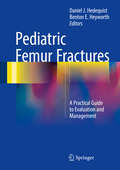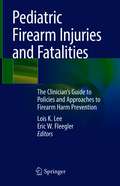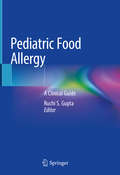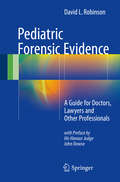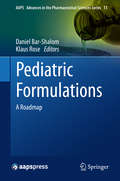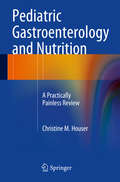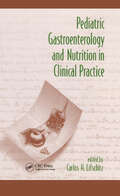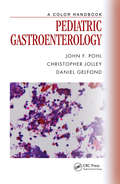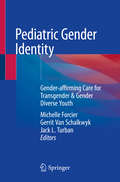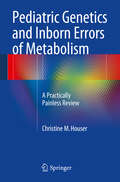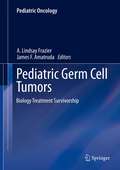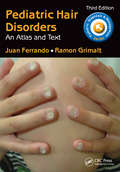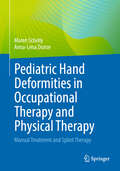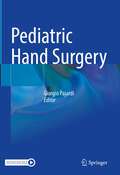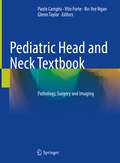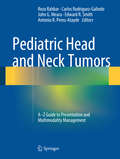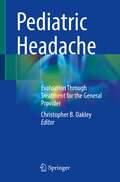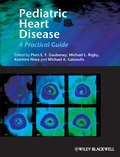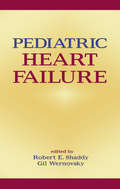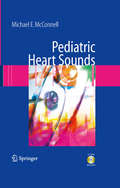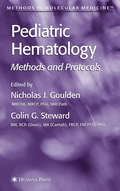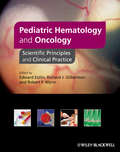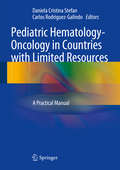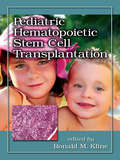- Table View
- List View
Pediatric Femur Fractures
by Daniel J. Hedequist Benton E. HeyworthBringing together the many considerations and complexities surrounding the management pediatric femur fractures, this up-to-date, comprehensive book discusses all aspects of these common but challenging injuries, where the treatment strategies are rapidly changing and which have the potential for complications and less than ideal outcomes. Because there may be multiple acceptable treatment approaches to a given fracture, we sought to review the full spectrum of therapeutic modalities. The entirety of the pediatric femur is considered, including femoral head and neck fractures, diaphyseal, physeal and epiphyseal fractures, and intra-articular fractures of the distal femur. Opening with chapters on development and anatomy as well as radiological evaluation, each fracture type-specific chapter discusses the indications and contra-indications, advantages and disadvantages, technical principles and published outcomes associated with each of the accepted techniques, from casting and traction to external and internal fixation. Concluding chapters discuss pathological fractures and the evaluation and management of complications. By channeling the expertise of a broad and accomplished group of authors with extensive experience in both researching and treating pediatric femur fractures, Pediatric Femur Fractures provides caregivers with the most complete and reliable resource when faced with any of the many types of this challenging injury.
Pediatric Firearm Injuries and Fatalities: The Clinician’s Guide to Policies and Approaches to Firearm Harm Prevention
by Lois K. Lee Eric W. FleeglerPediatric firearm injuries are a significant public and medical community issue. Clinicians are on the front line caring for children, adolescents, and their families after a firearm injury or death. They also represent the best hopes for preventing firearm injuries to children and adolescents in the future. In circumstances of injury and violence they provide medical, mental health, and rehabilitative care. They also provide anticipatory guidance to prevent firearm injuries and deaths and should have a strong voice in the local, state and national discussions about firearm policies for injury prevention. This book provides an overview of the epidemiology and risk factors for firearm injuries in children and adolescents. It will serve as a practical clinical guide for firearm injury prevention at the individual, state and national levels. The beginning of the book focuses on the epidemiology of firearm injuries, primarily centered in the United States, but also including an international perspective. It addresses the role of firearms in suicide, homicide, and domestic violence, and examines mass shootings as well. The second half of the book focuses on preventive measures for firearm injuries including primary care and hospital-based interventions, community interventions, and state and federal legislation. It concludes with a background on the history of firearm research in the United States and future directions for decreasing firearm injuries. The book’s overall focus is on public policy and the role of clinicians and public health advocates, while simultaneously offering practical tools and information about the clinician’s role in intervention. Written by experts in the field, Pediatric Firearm Injuries and Fatalities is an ideal resource for pediatric, adolescent medicine, emergency medicine, primary care and family medicine clinicians. At the same time, it appeals to all clinicians and public health advocates wishing to develop a better understanding of pediatric firearm injuries and a path forward to decreasing them.
Pediatric Food Allergy: A Clinical Guide
by Ruchi S. GuptaComprehensive and practical, this book thoroughly addresses the full range of concerns related to food allergies in the pediatric patient. As food allergies in the pediatric population increase in number and severity, Pediatric Food Allergy: A Clinical Guide provides information on new guidelines and potential treatment options, as well as working to improve awareness, diagnosis, management and prevention practices. Written by experts in their respective fields, chapters are divided into five sections. Opening with an introduction and overview of particular concerns and issues specific to food allergy in the pediatric population, sections two and three address diagnosis and management of comorbid conditions in food allergy, along with development of food allergies and current prevention recommendations. Sections four and five cover food allergy management, prognosis, and therapeutic options with a look to future developments, while all sections include a discussion of epidemiology, differential diagnoses of other potential food-related diseases. In Pediatric Food Allergy: A Clinical Guide, pediatricians and allergists alike will find an invaluable resource as they work with this vulnerable patient population.
Pediatric Forensic Evidence
by David L. RobinsonThis book provides guidance to all professionals working with children who present with injuries, neglect, illness falsification and other forms of child abuse. Clinical findings and the current literature are analyzed. The author's clinical experience is shared to assist the reader in diagnosing the cause of injury and other presentations. This text is the result of many years of experience in the UK working with children in an East London hospital (which receives over 1000 children a week through the children's Emergency Department) and the analysis of over 400 cases for the Family and Crown Courts. Mainstream opinions, the medical literature, and examples from extensive experience on the wards and in Court are discussed. Pediatric Forensic Evidence is aimed at doctors, lawyers, the Courts, social workers, health visitors, teachers, the police and others, guiding them through the analysis of injury and when to raise concerns.
Pediatric Formulations
by Daniel Bar-Shalom Klaus RoseUntil the 1990s, it was generally accepted that medicines were first developed for adults and their use in children was investigated later, if at all. One of the main tasks of hospital pharmacies was the manufacturing of child-appropriate formulations in a more or less makeshift way. The first change came in 1997 with U. S. legislation that rewarded manufacturers to do voluntary pediatric research. Ten years later, the European Union passed legislation that required manufacturers to discuss all pediatric aspects, including formulations, with the regulatory authorities as a condition of starting the registration procedure. In consequence, manufacturers must now cover all age groups, including the youngest ones. So far, pediatric formulations were more a focus for academic researchers. Through the changed regulatory environment, there is now a sudden high commercial demand for age-appropriate formulations. This book begins by highlighting the anatomical, physiological and developmental differences between adults and children of different ages. It goes on to review the existing technologies and attempts to draw a roadmap to better, innovative formulations, in particular for oral administration. The regulatory, clinical, ethical and pharmaceutical framework is also addressed.
Pediatric Gastroenterology and Nutrition
by Christine M. HouserOften, information in review books can raise as many questions as it answers. This interferes with the study process, because the learner must either look up additional information or skip ahead without truly comprehending what he or she has read. As an alternative, Pediatric Gastroenterology and Nutrition: A Practically Painless Review presents bite-size chunks of information that can be read and processed rapidly, helping learners to stay active while studying and to pick up new information the first time they read it. This book's question and answer format allows for self-testing or study with a partner or a group. The format also facilitates dipping into the book during a few minutes of downtime at the hospital or office. Pediatric Gastroenterology and Nutrition: A Practically Painless Review is a quick and easy way to master these tricky topics and is suitable for those studying for the pediatric board exam, practicing physicians brushing up their skills and any busy clinician who wants to learn more about these topics while on the go.
Pediatric Gastroenterology and Nutrition in Clinical Practice
by Carlos H. LifschitzCovers endocopic procedures and common surgical operations of the gastrointestinal tract and liver!Contains an overview of nutrition for normal and sick pediatric patients!Examines the supply, digestion, absorption, and metabolic utilization of lipids and their importance for growth, body composition, health, and well-being!Describing early detection and therapeutic approaches to hyperlipidemias in children and young adults, Pediatric Gastroenterology and Nutrition in Clinical Practice reveals the latest findings on protein and calcium requirements presents new information on specific nutrients used preferentially by the gut supplies the rationale for the exclusive use of human milk in breastfeeding infants explains the use of nucleotides in infant formulas and the emerging benefits of probiotics offers an overview of recent research and clinical experience in the enteral nutrition of premature infants details diagnoses and therapies for infants and children with severe feeding problems gives critical insight into intravenous nutrition considers the digestive enzymes and transporter proteins needed to absorb carbohydrates as well as the consequences of their deficiencies Addressing nutritional, metabolic, and mechanistic aspects of protein, Pediatric Gastroenterology and Nutrition in Clinical Practice is a comprehensive reference for pediatricians; pediatric gastroenterologists, hepatologists, and nutritionists; molecular biologists; geneticists; neonatologists; pathologists; and medical students in these disciplines.
Pediatric Gastroenterology: A Color Handbook (Medical Color Handbook Ser.)
by John F. Pohl Christopher Jolley Daniel GelfondHighly Commended, BMA Medical Book Awards 2015 <P><P>During the past 20 years, there has been an explosion of clinical, basic science, and translational research leading to a better understanding of the physiology and disease processes in the gastrointestinal system of children. Endoscopic techniques have improved, correlation of radiographic and biopsy f
Pediatric Gender Identity: Gender-affirming Care for Transgender & Gender Diverse Youth
by Michelle Forcier Gerrit Van Schalkwyk Jack L. TurbanThis book serves as a guide to key topics regarding pediatric gender identity to help clinicians better care for transgender and gender diverse youth. Written by experts in the field, it covers critical considerations for child health providers from a variety of disciplines in a range of clinical settings. Patients, families and other community agencies can also find useful information about current practices and recommendations for care and support. The text begins by overviewing terminology, epidemiology, gender identity development, and relevant neurobiology. Next, the text focuses on the emergence of affirmative treatment paradigms using a patient-centered, consent based framework. Topics include psychotherapeutic support, gender-affirming medical and surgical care, management of co-existing psychiatric conditions, sexual health and fertility, legal considerations, international considerations, and more. Pediatric Gender Identity can be used as a framework to address core clinical issues and offers practical considerations for gender-affirming care. Using the growing science and understanding of gender development, this book is an excellent resource for all professionals working with gender diverse youth, including child and adolescent psychiatrists, pediatricians, pediatric surgeons, psychologists, therapists, researchers, school and educational leaders, and students.
Pediatric Genetics and Inborn Errors of Metabolism
by Christine M. HouserOften, information in review books can raise as many questions as it answers. This interferes with the study process, because the learner must either look up additional information or skip ahead without truly comprehending what he or she has read. As an alternative, Pediatric Genetics and Inborn Errors of Metabolism: A Practically Painless Review presents bite-size chunks of information that can be read and processed rapidly, helping learners to stay active while studying and to pick up new information the first time they read it. This book's question and answer format allows for self-testing or study with a partner or a group. The format also facilitates dipping into the book during a few minutes of downtime at the hospital or office. Pediatric Genetics and Inborn Errors of Metabolism: A Practically Painless Review is a quick and easy way to master these tricky topics and is suitable for those studying for the pediatric board exam, practicing physicians brushing up their skills and any busy clinician who wants to learn more about these topics while on the go.
Pediatric Germ Cell Tumors
by A. Lindsay Frazier James F. AmatrudaGerm cell tumors are relatively rare compared with other malignancies, and compilations of knowledge that encompass the entire spectrum of the disease are lacking. This textbook, written by the foremost authorities in the field, rectifies the situation by discussing in depth a broad range of topics, including biology, epidemiology, pathology, treatment, and late effects. Bearing in mind that germ cell tumors are most prevalent in the adolescent and young adult age group, causes of disease and treatment approaches in pediatric and adult patients are compared and contrasted. By spanning the entire life course, from prenatal origins of disease through to treatment in adults and late effects of treatment, the editors have produced a book that will be of interest to both pediatric and adult oncologists.
Pediatric Gynecology: An Illustrated Guide for Surgeons
by Ahmed H. Al-SalemThis richly-illustrated book is a reader-friendly reference guide on pediatric gynecology covering both congenital and acquired conditions. Discussing a broad range of conditions from ovarian cysts and endometriosis to disorders of sexual development and breast disorders, this book presents the topics in a concise manner using a practical approach. Each chapter is divided into sections that cover all aspects of the topic including radiology, surgery and clinical aspects and the text is accompanied by ample images.The book will be of use to general surgeons, pediatricians, pediatric surgeons, pediatric endocrinologists, pediatric urologists, obstetricians and gynaecologists.
Pediatric Hair Disorders: An Atlas and Text, Third Edition (Pediatric Diagnosis and Management)
by Juan Ferrando Ramon GrimaltHair problems in child patients present a particular problem for clinicians: dermatologists, pediatricians, and family physicians can all worry they may not be up to date with what may be happening in the other specialties potentially involved. Written by authors with an international reputation, the new third edition of Pediatric Hair Disorders is full of clinical pictures, with a clear and concise text to help with the diagnosis of each entity. It will be helpful for all clinicians in training and in practice needing a quick and very visual resource to help with clinical diagnosis and to be confident they are using the best recommended techniques.
Pediatric Hand Deformities in Occupational Therapy and Physical Therapy: Manual Treatment and Splint Therapy
by Maren Schelly Anna-Lena DunseThis practical guide provides essential foundations for the treatment of pediatric hand deformities in occupational therapy and physical therapy. How is the function of the deformed hand assessed? When does the intensive manual treatment and splint therapy begin for congenital flexion contractures? From when must manual therapy commence after pollicization? The experts provide you with the answers! From the Content:Anatomical and Motor Development of the HandHand Deformities, including radial longitudinal reduction defect, camptodactyly, and arthrogryposisScar TreatmentOrthotic Care Plus: Additional chapter on tips, tricks, and further informationEmpower your littlest patients for increased independence and quality of life!
Pediatric Hand Surgery
by Giorgio PajardiThis book describes and illustrates surgical procedures of proven efficacy in infants and children with congenital hand deformities, hand traumas, hand dysfunctions due to obstetric palsy of brachial plexus. Essential background information is first provided on anatomy, hand development, and patterns of use. Extensive sections are then devoted to the surgical treatment of trauma to different parts of the hand and each of the relevant congenital conditions. Full guidance on treatment choice is provided, with description of the treatment pathways appropriate in different circumstances and explanation of the impact of patients’ young age on the surgical approach. Readers will learn about the complex features that may be masked even by the simplest congenital condition such as syndactyly and about the implications for treatment. In depth information is also provided on the character and vital role of rehabilitation in the pediatric population. Pediatricians, hand surgeons, plastic surgeons, pediatric surgeons, rheumatologists, neurologists, and physiotherapists will all find that the book improves their clinical practice.
Pediatric Head and Neck Textbook: Pathology, Surgery and Imaging
by Glenn Taylor Paolo Campisi Vito Forte Bo-Yee NganThis book focuses on Pediatric Head and Neck Surgical Diseases and Pediatric Surgical Pathology. The core objective is to provide the reader the essential background of various head and neck diseases that are common and/or unique to children by highlighting the key diagnostic, clinical, and pathologic features. It encompasses a comprehensive spectrum of pediatric head and neck diseases that are congenital or acquired. Many chapters describe the clinical and radiologic presentation, age-specific differential diagnosis, and diagnostic histopathologic features. The clinical and pathologic aspects of diseases that are unique to children and young adults that are amenable to surgical care are specifically emphasized. Pediatric Head and Neck Textbook: Pathology, Surgery and Imaging is aimed at trainees and specialists in Pediatrics, Otolaryngology – Head & Neck Surgery, General and Pediatric Surgery, Pediatric Radiology and Pediatric Pathology.
Pediatric Head and Neck Tumors
by Carlos Rodriguez-Galindo Edward R. Smith Reza Rahbar John G. Meara Antonio R. Perez-AtaydeThe pediatric head and neck cancer patient necessitates a multidisciplinary team of specialists to provide an optimal continuum of care. This A-Z guide provides practical, in-depth information for all medical professionals involved in the evaluation and treatment of these patients. Written in an easy to follow format, each entry contains illustrative figures to aid in pathological and radiographical diagnosis, as well as structured discussion of evaluation and multimodality management. The alphabetical layout eliminates redundancy and allows the busy physician to quickly locate relevant information. Pediatric Head and Neck Tumors is ideal for young physicians as well as attending physicians seeking to expand their knowledgebase to the various subspecialties involved in the multidisciplinary care of their patients.
Pediatric Headache: Evaluation Through Treatment for the General Provider
by Christopher B. OakleyPediatric headache is the most common neurological complaint that presents to the general pediatrician, urgent care and emergency rooms, and to pediatric neurology. Despite how common headaches are in the pediatric population and how many children continue to suffer from their headaches on a daily basis, there remains a tremendous disconnect for those tasked with being the first-line providers (general pediatric providers). This stems from the fact that headache patients can be so variable and challenging, with numerous comorbid concerns, all the while requiring an individualized treatment approach without a cure.The purpose of this proposed book is to help foster a better understanding of how to approach, assess, and ultimately treat pediatric headache for the general pediatric provider in an attempt to make what once was a daunting, overwhelming complaint from patients and their families into something each general pediatric provider can conquer with confidence. With the aid of experts in the field of pediatric headache, this book will begin by providing the foundation as to what types of headaches, primary and secondary as well as their precursors, are commonly seen in the pediatric population. From there, the focus will turn to when should the provider worry about a patient who presents with headaches. The clinic visit -- from the history to the “red flags” to the pertinent exam -- will be reviewed in depth to help distinguish between primary and secondary headaches as well as who warrants an evaluation. Additionally, comorbid concerns will be covered as these may have direct impact on the evaluation and subsequent treatments offered. The next section will delve into the treatment of pediatric headache with a comprehensive approach covering everything from lifestyle to complementary and alternative therapies/treatments, to medications, both acute and prophylactic. Other more specialized treatment options such as procedures and devices will also be discussed albeit these options are more likely to be offered by a specialist rather than a general provider. A subsequent section will highlight the unique challenges for the older adolescent patients as they transition into young adulthood. The closing section will highlight the future of pediatric headache.
Pediatric Heart Disease: A Clinical Guide
by Michael Rigby Koichiro Niwa Michael Gatzoulis Piers DaubeneyA companion book to Adult Congenital Heart Disease that will concentrate on the practical management of children with heart conditions. <P><P>This is aimed at general paediatricians and physicians who are responsible for ongoing management, rather than specialists concerned with acute or rare presentations. The book will be illustrated with relevant radiology scans, demonstrating which investigations are appropriate, and will provide the relevant information for the generalist on patient management for different lesions. A section on emergency management is also included. Authorship is international, with contributions from both sides of the Atlantic and from Japan.
Pediatric Heart Failure
by Gil Wernovsky Robert E. ShaddyThe first book of its kind, this reference describes current diagnostic and treatment strategies for acute and chronic heart failure in the fetus, neonate, child, and young adult-encompassing every aspect of pediatric heart failure including historical perspectives, the latest technologies in mechanical circulatory support, and recent information o
Pediatric Heart Sounds
by Michael E. Mcconnell Alan BraniganPediatric Heart Sounds offers in-depth tutorials of specific pediatric heart sounds and a diagnosis of those sounds. A self-assessment option helps the viewer to recognize the audio features of a heart condition as well as how to analyze logically and 'dissect' the murmur to improve identification. The book is designed to provide explanation of the mechanisms involved.
Pediatric Hematology
by Colin G. Steward Nicholas J. GouldenA collection of cutting-edge methods for investigating and detecting a wide variety of hematological disorders. Here, the reader will find reliable molecular protocols for the diagnosis of Fanconi anemia and dyskeratosis congenita, immunodeficiency, and most forms of hemoglobinopathy. In addition, there are detailed methods for molecular human platelet antigen genotyping, an effective PCR procedure for thrombophilia screening, and protocols for fluorescent in situ hybridization. Since the measurement of minimal residual disease (MRD) provides a much more accurate risk-directed therapy, three methods are presented for detecting residual leukemia below the threshold of light microscopy, along with relatively simple, rapid, and cheap methods for the detection of MRD in ALL and AML.
Pediatric Hematology and Oncology
by Edward Estlin Rob Wynn Richard GilbertsonThis new textbook has an international authorship and is a practical, up-to-date resource for clinicians responsible for the care of children with oncologic and malignant hematologic disease. It is specifically designed for practicing oncologists and hematologists, pediatricians with an interest in childhood cancer and trainees seeking a systematic approach to these disorders. This new textbook has an emphasis on the visual presentation and ease of reading of contemporary and comprehensive information for children's cancers and contains detailed tables, fact boxes and illustrations.The textbook begins with an introduction to the general principles of the scientific foundation and treatment of childhood cancers and hematological malignancies. Separate sections are then devoted to descriptions of central nervous system tumors, hematological malignancies and solid tumors of childhood which encompass epidemiology, cellular and molecular biology, cancer genetics, immunology, pharmacology and the findings of clinical trials. For each area of science covered, key original references and reviews are highlighted to direct further reading.Diagnostic, biological, and therapeutic issues are integrated into each tumor-specific chapter, with evidence supporting the current rationales for risk stratification and the development of novel therapies. A final section then explores supportive care, palliative care, late effects considerations and psychosocial issues as relate to children's cancer.
Pediatric Hematology-Oncology in Countries with Limited Resources
by Daniela Cristina Stefan Carlos Rodriguez-GalindoTypically, manuals of pediatric hematology-oncology are written by specialists from high-income countries, and usually target an audience with a sub-specialist level of training, often assisted by cutting-edge diagnostic and treatment facilities. However, approximately 80% of new cases of cancer in children appear in mid- and low-income countries. Almost invariably, general practitioners or general pediatricians without special training in oncology will look after children with malignancies who enter the health care system in these countries. The diagnostic facilities are usually limited, as are the treatment options. The survival figures in these conditions are somewhere below 20%, while in high-income countries they are in the range of 80% for many childhood cancers. Pediatric Hematology-Oncology in Countries with Limited Resources is the only book of its kind to provide specific guidance applicable to limited resource settings and builds up from the foundation of general practitioner or general pediatrician competence. Written and edited by leaders in the field, this manual educates physicians on the essential components of the discipline, filtered through the experience of specialists from developing countries, with immediate applicability in the specific healthcare environment in these countries.
Pediatric Hematopoietic Stem Cell Transplantation
by Ronald M. KlineHematopoietic stem cell transplantation (HSCT) is currently utilized as a treatment option for a variety of life-threatening conditions affecting children and young adults including leukemia, lymphoma, neuroblastoma, brain tumors, inherited immune deficiency syndromes, blood disorders, and inherited metabolic diseases. This expertly written referen
